Worshipped as gods in many ancient South American cultures, jaguars are powerful cats. They’re the kings of the Amazon Rainforest.
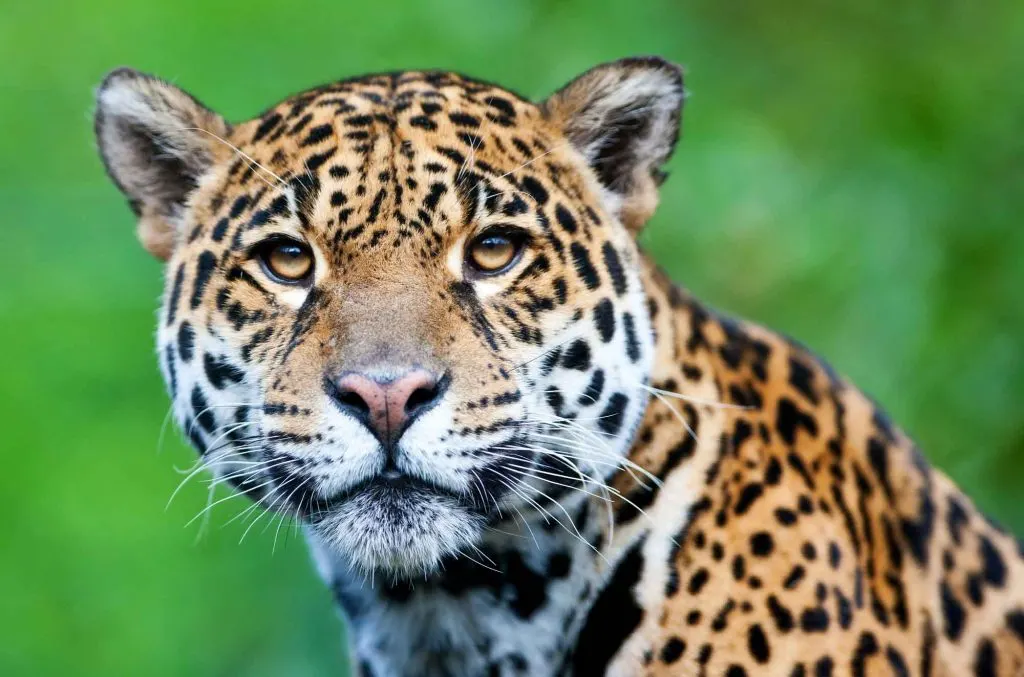
Jaguar
Panthera Onca
Jaguar Scientific Classification
- Kingdom: Animalia
- Phylum: Chordata
- Class: Mammalia
- Order: Carnivora
- Family: Felidae
- Genus: Panthera
- Species: Pantera Onca
Jaguar Appearance
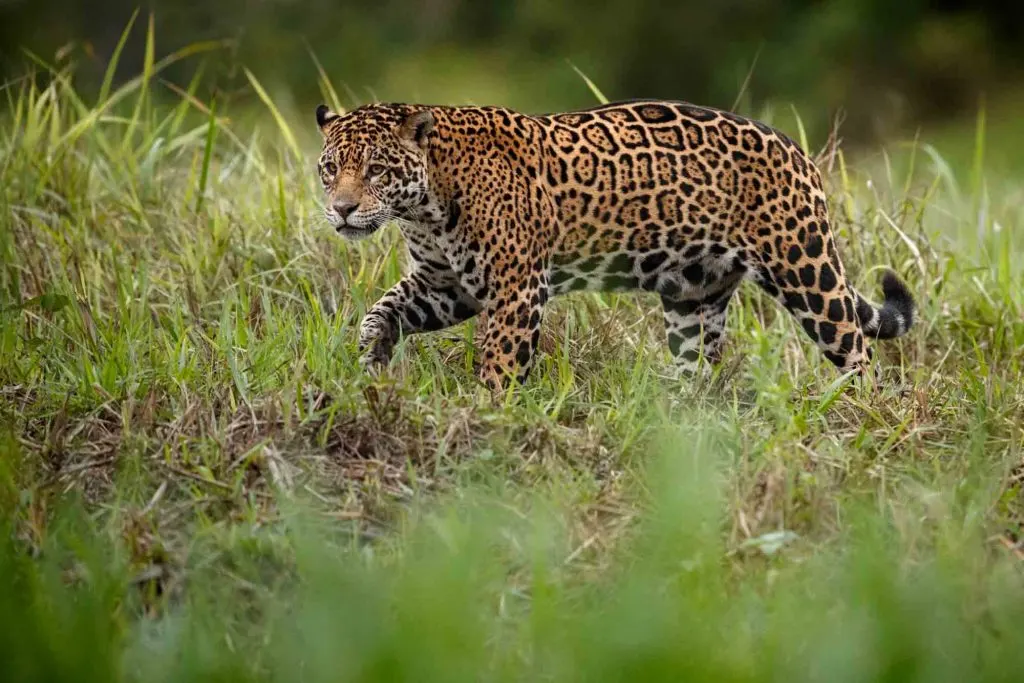
- Lifespan: 12-16 years
- Length: 60-72 inches
- Tail: 27.5-36 inches
- Height: 2.1-2.5 feet
- Weight: 100-250 pounds
- Top speed: 50 mph
The jaguar is a compact, slender, and muscular animal. The pale yellow to tan-colored coat is uniquely marked with dark rosette spots. Their sides and underbellies are lighter in color. Each spot is different, and they vary in shape. Rosettes may even include several dots instead of one.
Marks on the head and neck are solid, while those on the tail combine together to form band-like markings. The spotted fur coat helps these big cats camouflage in areas that have dense vegetation and patchy shadows.
Jaguars that live in the forests are usually darker and smaller than those living in open areas.
These big cats are similar to leopards in their appearance, but jaguars are more robust with sturdier limbs and squarish heads. Rosette spots on jaguar coats are more prominent, darker, and fewer in number. They have thicker lines with a tiny spot in the middle.
Did you know? The jaguar is the largest big cat in the Americas and the third-biggest in the world, after only tigers and lions.
Jaguar Range & Habitat
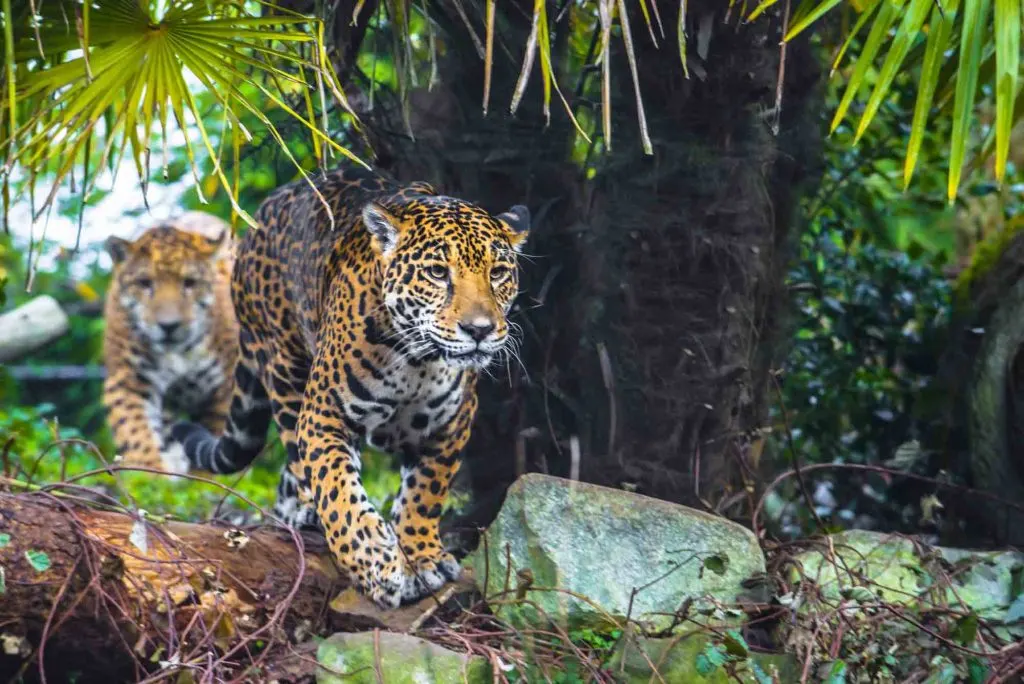
Jaguars are the largest wild cats in the Americas. Their range extends from the southwestern region from the United States through Mexico and Central America to South America, and they’re sympatric with the cougar depending on the local prey availability.
Despite this broad range, jaguars have been eradicated from 40% of their historic range and are extinct in Uruguay and El Salvador.
Beyond that, jaguars are primarily found in South America’s rainforest, the Brazilian Amazon Rainforest.
These big cats like to live in dense forests, including dry deciduous, tropical, and subtropical, as well as in rainforests. They are often found near rivers, lakes, or wetlands as they’re great swimmers.
Distribution
- Continents: South America and North America.
- Countries: Argentina, Belize, Bolivia, Brazil, Colombia, Costa Rica, Ecuador, Guatemala, Guyana, Honduras, Mexico, Nicaragua, Panama, Paraguay, Peru, Suriname, United States, and Venezuela.
Habitat
Forest | Savanna | Shrubland | Grassland | Wetlands (inland)
Jaguar Behavior and Lifestyle
Jaguars are mainly active in the night and during twilight.
However, the big cats that live in the densely forested areas of the Amazon Rainforest are mostly active during the day. Their activity pattern depends on their main prey species.
Jaguars use their claws and agile body movements to climb and swim.
They usually live in solitude, except for female jaguars who live with cubs. They are territorial cats that mark their property using scrape marks, urine, and feces.
Jaguar Diet
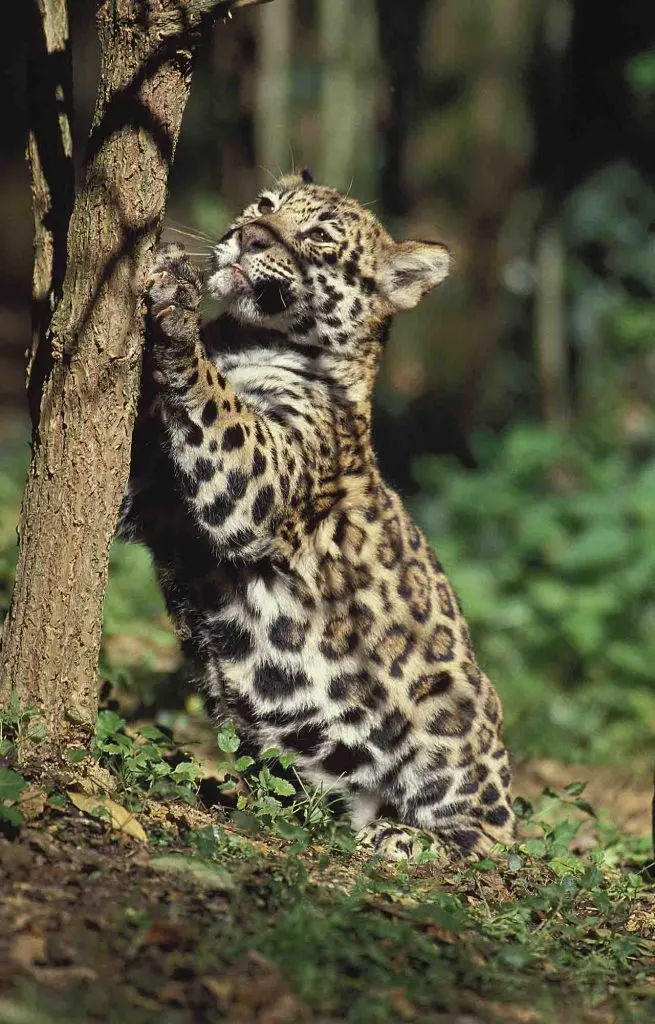
Jaguars are at the top of the food chain, making them apex predators. For that reason, these carnivorous big cats’ food habits are made up of animals’ flesh for their nutrition.
They prefer to hunt wild animals such as capybara and giant anteaters. Their diet may also include marsh deer, southern tamandua, collared peccary, and black agouti.
When they are near rivers or in floodplains, jaguars will hunt reptiles like turtles and caimans. The long and sharp canines of jaguars allow them to tear through the shells and tough skin of reptiles.
Also, jaguars chase down cattle and other livestock where wild prey is scarce.
The jaguar’s bite is so sharp that it pierces through the carapaces (the shell) of the yellow-spotted Amazon river turtle. This force also allows them to use an unusual method of finishing their prey.
They bite down hard on mammals–between the ears and through their skulls–to deliver a direct fatal blow to the brain. But for larger prey, they will attack the neck to suffocate their victims.
Rather than chasing them down, jaguars use a stalk-and-ambush strategy to hunt their prey. These big cats will blend into their surroundings and slowly walk the forest paths. They listen to animals they can pursue.
Once the jaguars lock down on their prey, they will track and stalk these animals for a while, waiting to charge. When the moment arrives, they will rush in from their blind spot and ambush their prey with a quick pounce.
Jaguar Reproduction and Mating
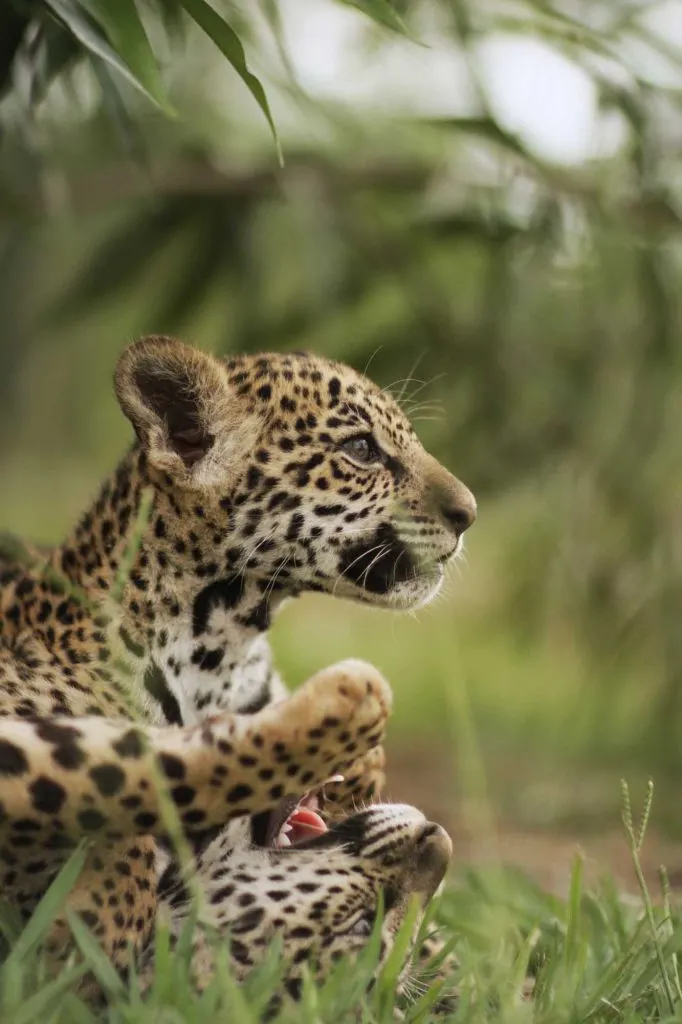
Female jaguars get ready for mating when they reach the age of 2.5 years. They can reproduce throughout the year, but the birth rates vary seasonally. Cubs are generally born during the rainy season.
Females start vocalizing to attract males. They release roars and growls. While several male jaguars will follow a female, they rarely fight for mating.
These pairs form a temporary association, with the partners separating after five days. But, while courting, the couples will travel and feed together.
Female jaguars are induced ovulators, but they are capable of ovulating spontaneously. Their gestational period lasts between 91 to 111 days. Twin cubs are most common among jaguars, but a litter of up to four cubs may be born.
The cubs are born with their eyes closed, and will only open their eyes after two weeks of being born.
Cubs are weaned at three months, but they stay hidden in their mother dens for up to six months. Then, they will accompany their mothers on hunting trips. Jaguars will remain with their mothers for about two years before leaving.
Jaguar Conservation Status
Near threatened[1]
Jaguar Predators and Threats
Being apex predators, they do not fear other wildlife.
However, they are threatened by habitat loss, fragmentation of land, illegal poaching and execution, and trade in jaguar body parts.
It appears that with increasing Chinese investment in Latin America, demand for jaguar parts, like fangs and claws, is rising again, driving illegal jaguar hunting and poaching, even in strongholds like the Amazon.
Humans also hunt them for their jugular fangs, skins, and fur coats and execute them out of fear.
Beyond that, deforestation of forests, especially the Amazon, is a significant threat to the survival of jaguars.
Their population is declining steadily as they face habitat loss.
Jaguar Facts
Here’re some interesting and fun facts about jaguars:
- The name ‘jaguar’ comes from the South American indigenous word ‘yaguar,’ which means ‘he who kills with one leap’ or ferocious beast.
- Jaguars are excellent swimmers and live near the waters, unlike other big cats.
- Jaguars often roar. Their roar is called ‘saw’ as it sounds like sawing wood. They use their roar as a mating call or to greet each other.
- South American jaguars are larger than those of Central America.
- They are not picky eaters. Jaguars are opportunistic hunters that will prey on any animal.
- Some jaguars have such dark fur coats that the spottings cannot be seen. These black jaguars are also called black panthers.
- Jaguars have an incredibly strong set of jaws. The force behind each bite and their razor-sharp teeth can pierce through tough shells of turtles and tortoises and crack the skulls of their prey.
- The best place to spot a jaguar is in Pantanal, Brazil. The best time to visit is during the dry season, from late April to early November.
- The oldest jaguar to date is Micica, a female jaguar that has lived since 1994 in the ZOO Osijek in Croatia. The last data showed Micica was 29 years and six months old in 2017. There has been no update on her condition since then.
